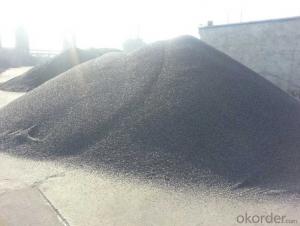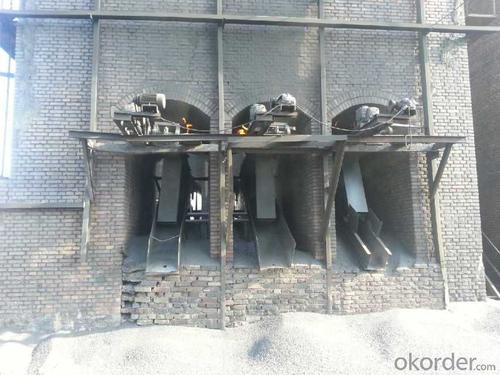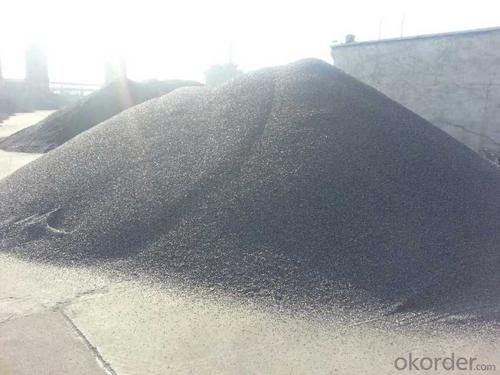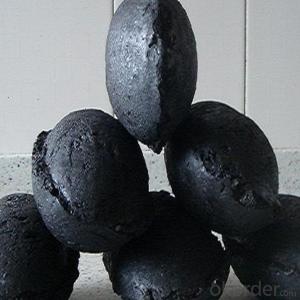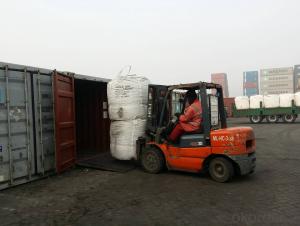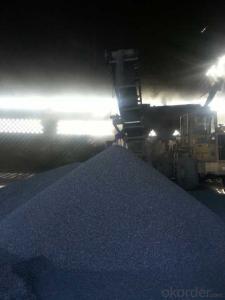Calcined Anthracite FC90-95 With High Quality
- Loading Port:
- Lianyungang
- Payment Terms:
- TT OR LC
- Min Order Qty:
- 20 m.t.
- Supply Capability:
- 3500 m.t./month
OKorder Service Pledge
OKorder Financial Service
You Might Also Like
Calcined Anthracite FC90-95
Packaging & Delivery
25kgs/50kgs/1ton per bag or as buyer's request
Features
Calcined Anthracite
Fixed carbon: 90%-95%
S: 0.5% max
Size: 0-3. 3-5.3-15 or as request
It used the high quality anthracite as raw materials through high temperature calcined at over 2000 by the DC electric calciner with results in eliminating the moisture and volatile matter from anthracite efficiently, improving the density and the electric conductivity and strengthening the mechanical strength and anti-oxidation. It has good characteristics with low ash, low resistvity, low sulphur, high carbon and high density. It is the best material for high quality carbon products.
Advantage and competitive of caclined anthracite
1. strong supply capability
2. fast transportation
3. lower and reasonable price for your reference
4.low sulphur, low ash
5.fixed carbon:95% -90%
6..sulphur:lower than 0.3%
General Specification of Calcined Anthracite
| FC | 95 | 94 | 93 | 92 | 90 |
| ASH | 4 | 5 | 6 | 6.5 | 8.5 |
| V.M. | 1 | 1 | 1 | 1.5 | 1.5 |
| S | 0.3 | 0.3 | 0.3 | 0.35 | 0.35 |
| MOISTURE | 0.5 | 0.5 | 0.5 | 0.5 | 0.5 |
Pictures

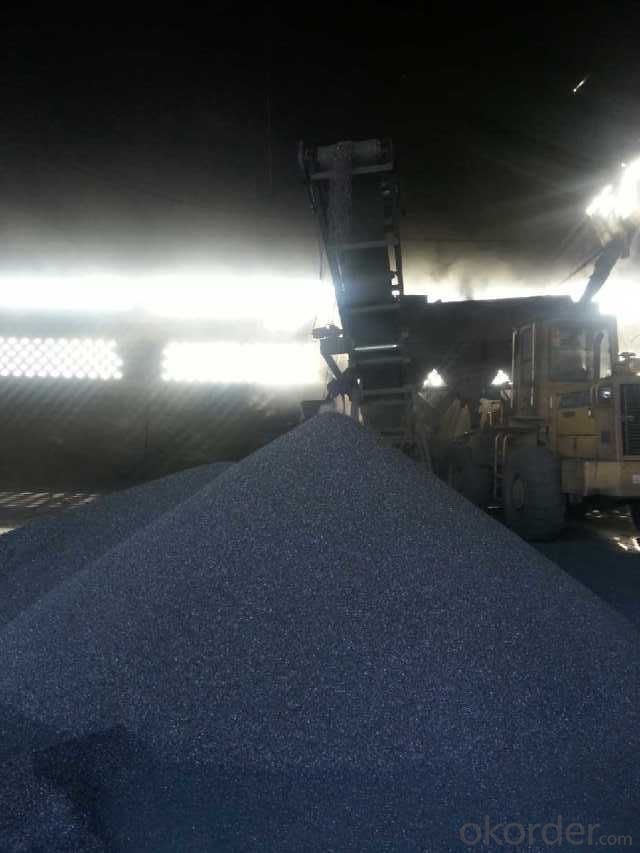
- Q: What is carbon black dye?
- Derived from carbon black, a fine black powder resulting from the incomplete combustion of hydrocarbon materials, carbon black dye is a highly sought-after dye. It finds extensive usage as a pigment and dye across various industries, such as ink, paint, rubber, plastics, and textiles. Renowned for its intense black hue and exceptional lightfastness, carbon black dye resists fading when exposed to sunlight or other light sources. Moreover, this dye's strong coloring properties enhance the depth and darkness of other colors, rendering them more visually appealing and vibrant. Furthermore, carbon black dye boasts remarkable heat stability, chemical resistance, and electrical conductivity, making it versatile for a wide array of applications.
- Q: How is carbon used in the production of adhesives?
- Carbon is used in the production of adhesives as a key component in creating the adhesive's base material. Carbon-based compounds, such as resins or polymers, are often used to form the adhesive's structure, providing strength, flexibility, and adhesion properties. These carbon-based materials can be synthesized or derived from natural sources like petroleum or plants. Overall, carbon plays a crucial role in the formulation of adhesives, enabling them to bond various materials together effectively.
- Q: How does carbon affect the formation of earthquakes?
- The formation of earthquakes is not directly influenced by carbon. The primary cause of earthquakes is the movement of tectonic plates, which are large sections of the Earth's crust that float on a semi-fluid layer underneath. These plates can collide, slide past each other, or move apart, resulting in stress building up along the boundaries between the plates. When this stress becomes too great, it is released as an earthquake. Nevertheless, carbon can indirectly impact the occurrence of earthquakes through its role in the Earth's carbon cycle and its contribution to climate change. Carbon dioxide (CO2) is a greenhouse gas, which is released into the atmosphere through various human activities, including the burning of fossil fuels. This excess CO2 in the atmosphere leads to global warming and climate change. Climate change can have several effects on the Earth's crust, some of which may indirectly influence seismic activity. For instance, global warming can cause the melting of glaciers and polar ice caps, resulting in changes in the distribution of mass on the Earth's surface. This redistribution of mass can cause adjustments in the Earth's crust, leading to increased stress along fault lines and potentially triggering earthquakes. Furthermore, climate change can affect groundwater levels and pore pressure within rocks through changes in precipitation patterns and the hydrological cycle. These alterations in water content can modify the strength and stability of fault lines, making them potentially more susceptible to slipping and causing earthquakes. It is crucial to note that the direct impact of carbon on earthquake formation is minimal compared to primary factors like plate tectonics. However, scientists are conducting ongoing research and investigations to understand the relationship between carbon emissions, climate change, and seismic activity.
- Q: How does carbon dioxide affect climate change?
- Climate change is significantly influenced by carbon dioxide (CO2), a greenhouse gas. CO2 is released into the atmosphere through natural processes like volcanic eruptions or human activities such as burning fossil fuels. Its presence in the atmosphere traps heat from the sun, preventing it from escaping back into space. This phenomenon is known as the greenhouse effect. Human activities, particularly the burning of fossil fuels like coal, oil, and natural gas, have led to an imbalance in the natural carbon cycle. This has caused an increase in CO2 concentration in the atmosphere, resulting in a rapid rise in global CO2 levels. Consequently, the Earth's surface is warming, and climate patterns are changing. Since the Industrial Revolution, the burning of fossil fuels has significantly elevated atmospheric CO2 levels, leading to an increase in the Earth's average temperature. This temperature rise impacts various aspects of the climate system, causing a range of effects. One of the most visible outcomes of increased CO2 levels is global warming. This warming leads to the melting of glaciers and polar ice, which in turn raises sea levels. Rising sea levels pose a threat to coastal areas and low-lying islands, causing increased flooding, coastal erosion, and potential displacement of communities. Moreover, elevated CO2 levels contribute to more frequent and intense heatwaves, droughts, and wildfires in many regions. These extreme weather events negatively affect agriculture, water availability, and human health. Carbon dioxide also disrupts ecosystems by altering the growth patterns and distribution of plant and animal species. Changes in temperature and precipitation patterns, driven by increased CO2 levels, disturb the delicate balance of life, leading to biodiversity loss and potential species extinction. To mitigate the impacts of CO2 on climate change, it is crucial to reduce greenhouse gas emissions. Transitioning to renewable energy sources, improving energy efficiency, and adopting sustainable practices are important steps in reducing CO2 emissions and limiting the extent of climate change. Additionally, efforts to restore and protect forests and other natural carbon sinks can help absorb and store CO2, thus mitigating its effects on the climate.
- Q: How much is a ton of carbon fiber? How much difference is made between domestic and imported?
- To 12K carbon fiber, for example, domestic prices between 16~17 million, imports of Dongli carbon fiber prices between 27~29 million.
- Q: I bought a grill myself and went to barbecue with my friends the day after tomorrow, but I can't ignite the carbon. What should I do?
- Use alcohol to pile up the carbon into Pyramid type. Bring the alcohol up for a minute and then ignite. If there is no alcohol, buy a bottle of water from the building materials store
- Q: What does "2T-250,1U-200@300" and "1Y-100" mean in carbon fiber cloth reinforcement?
- the indicates that the U type hoop is 200 wide and the spacing is 300; the 1Y-100 represents the width of the 100 width and each of the two sides of the beam. The units are mm.
- Q: What is carbon neutral packaging?
- Packaging that is carbon neutral is characterized by having no carbon footprint. This implies that the emissions of carbon dioxide (CO2) released during the production, transportation, and disposal of the packaging are counterbalanced by an equal amount of CO2 being removed from the atmosphere or not emitted in the first place. To achieve carbon neutrality, a range of strategies can be implemented. One commonly used method is to utilize renewable or recycled materials for packaging, such as paper or bioplastics derived from plant-based sources. These materials have a lower carbon footprint compared to traditional petroleum-based plastics. Furthermore, reducing the quantity of packaging used overall and optimizing its design to minimize waste can also contribute to carbon neutrality. Offsetting unavoidable emissions is another crucial aspect of carbon neutral packaging. This can be accomplished by investing in projects that reduce greenhouse gas emissions elsewhere, such as reforestation or renewable energy initiatives. By supporting these projects, the carbon emissions produced by the packaging are counteracted, resulting in no overall impact on the environment. The concept of carbon neutral packaging is gaining traction as businesses and consumers become more cognizant of the environmental consequences of their choices. It offers a means to decrease the carbon footprint associated with packaging, ultimately contributing to a more sustainable and environmentally friendly future.
- Q: What does carbon burning mean?
- Put the burning carbon under the iron plate and make a copy of it on the iron plate, that is, carbon burning!
- Q: Today in the market to buy Yuba, instructions have such a word that I don't understand, please master Zhijiao: carbon fiber after energized carbon molecule formation of Brown movement, this movement can be effective in most of the electrical energy into the far infrared.
- When it is energized, its motion intensifies, the frequency becomes V2, and the frequency becomes larger, the vibration system is unstable and the frequency is back to its original frequency. So you have to release energy in the form of electromagnetic waves. I am not too clear about the specific release process. I know that the molecules do slow motion and generate additional electromagnetic waves. The frequency of the extra electromagnetic wave emitted is v2-v1, and its frequency falls in the far infrared region.
Send your message to us
Calcined Anthracite FC90-95 With High Quality
- Loading Port:
- Lianyungang
- Payment Terms:
- TT OR LC
- Min Order Qty:
- 20 m.t.
- Supply Capability:
- 3500 m.t./month
OKorder Service Pledge
OKorder Financial Service
Similar products
Hot products
Hot Searches

